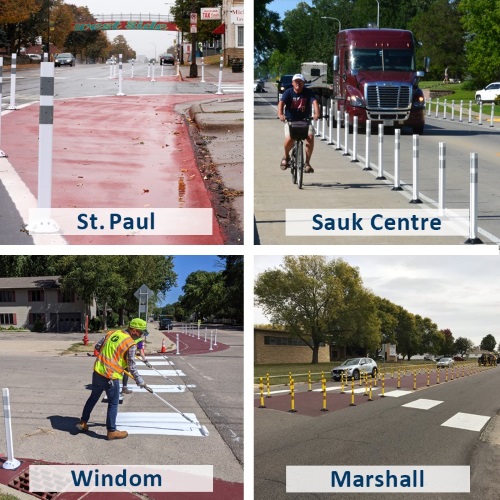The Minnesota Department of Transportation unveiled its first Statewide Pedestrian System Plan, which provides policy and investment guidance to improve places where people walk across and along Minnesota highways.
[Photo courtesy of the Minnesota Department of Transportation.]
The agency said the plan “identifies priority areas for investments” and lays out specific strategies to improve walking availability and accessibility now and for the next 20 years to help Minnesota’s communities plan for the future. It will be accepting public feedback on this plan through January 11, 2021.
“Our state’s quality of life depends on creating safe places for people to walk—to work, to the doctor, to the grocery store, anywhere. We know safety is a priority every time you walk,” explained Margaret Anderson Kelliher, Minnesota DOT’s commissioner, in a statement. “MnDOT’s first Statewide Pedestrian System Plan serves as a framework for how we plan to meet pedestrian needs and interests in our state, and we welcome public feedback on the plan.”
The agency said it began work on its Statewide Pedestrian System Plan in February 2019, building it in part on two public engagement efforts that reached 2,700 people statewide. The Minnesota DOT said it also installed seven pedestrian safety demonstrations projects across Minnesota to highlight specific pedestrian safety measures in action, with “all of that feedback” going through an internal process of evaluation to help the agency achieve “better outcomes” for people when walking.

“This effort will help MnDOT identify opportunities and implement the right strategies on projects to make walking safer and more convenient for Minnesotans,” added Jake Rueter, pedestrian and bicycle planner for the agency. “The plan doesn’t tell us exactly what to do in every situation, but it provides the tools we need to make those decisions and create better places for people to walk statewide.”
Meanwhile, on the national level, the U.S. Department of Transportation issued what it is calling a “first-of-its-kind” Pedestrian Safety Action Plan on November 23 – a plan that will be overseen by the Federal Highway Administration and National Highway Traffic Safety Administration.
“This unprecedented comprehensive safety effort is focused solely on protecting pedestrians because crossing a street should not be lethal for thousands of adults and children every year,” noted U.S. Transportation Secretary Elaine Chao in a statement – adding that USDOT’s plan will promote the expanded use of countermeasures, technology, and data-driven practices to address pedestrian fatalities and injuries.
According to NHTSA’s Fatality Analysis Reporting System, pedestrians comprised 17 percent of all traffic fatalities in 2019. In 2019 – the most recent year in which data is available – 6,205 pedestrians died in traffic crashes, which is 44 percent more compared to 2010.
Concurrently, the Transportation Research Board released a new National Cooperative Highway Research Program report – Availability and Use of Pedestrian Infrastructure Data to Support Active Transportation Planning – that documents the ways state departments of transportation are collecting, managing, sharing, and analyzing pedestrian infrastructure data.
The group said case studies in the report cover a diverse group of states, such as Kentucky, Louisiana, New Hampshire, Utah, and Washington State. By looking at current practices, TRB said in a blog post that state DOTs “can move forward in tailoring the data collection process to build infrastructure that will lead to more consistent and efficient planning and management of pedestrian infrastructure.”

